12.10.2019
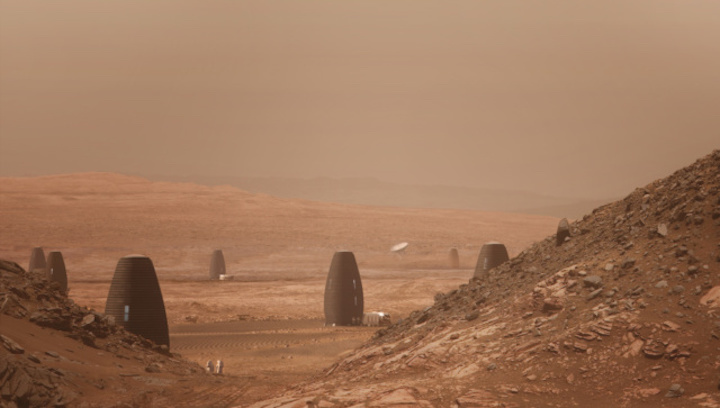
An outpost of AI SpaceFactory's 3D-printed MARSHA habitats. (Courtesy AI SpaceFactory and Plomp)
In early September of this year, I was at a conference at an aviation museum in Seattle, to lend some architectural context to ideas about long-term living in space. The folks at the Space Studies Institute (SSI) had invited me to talk about some of the research on NASA’s 1970s proposals to build huge rotating cities in orbit from my book, Space Settlements, as part of a panel on habitat design. This conference was commemorating two anniversaries; it had been 50 yearssince the Apollo 11 moon landing, and 50 years since Gerard O’Neill, a Princeton physics professor—and the leader of the 1970s NASA work—had asked a question of his freshman intro students: “Is the surface of a planet really the right place for an expanding technological civilization?” The answer they arrived at, after much study, was “no,” and they started to imagine the technical details of living elsewhere.
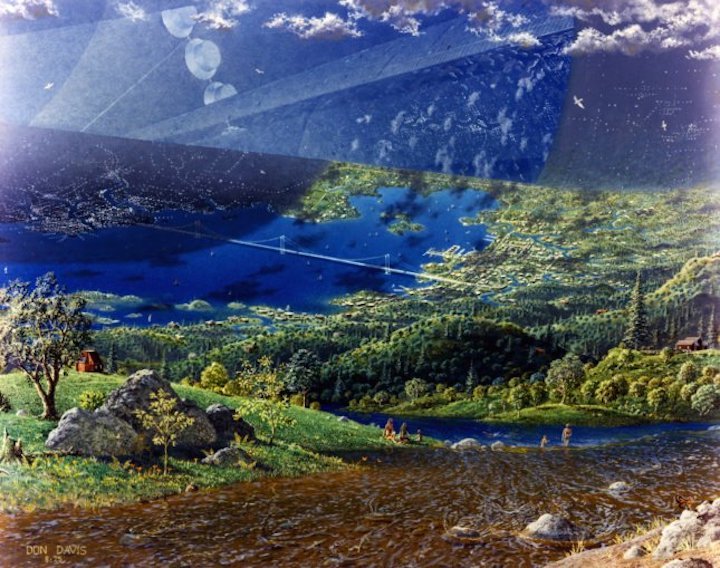
The Bay Area inspired Don Davis for this painting of a prospective cylinder colony, which would house over a million people. (NASA Ames Research Center/Don Davis)
My interest in this question has as much to do with history and culture as it does with getting down to the details of execution. “Why do we make space and live in it?” is a question worth asking, whether on Earth or off of it. But, while the conference itself was a fascinating two days of discussion, I was surprised to find that almost everyone there considered O’Neill’s (and my) questions to have been settled long ago. Why, the other panelists seemed to wonder, would anyone even ask “why” humans should go and live in outer space, when we can instead talk about “how?” And so that was the subject of the next two day’s conversation.
50 years on from Neil Armstrong and Buzz Aldrin’s historic flight—the culmination of almost a decade’s worth of work and about $150 billion in 2019 dollars—that “how?” seems easier than ever to answer. As of writing, it costs Elon Musk’s company SpaceX about $1,500 to launch 1 kilogram (2.2 pounds) into Low Earth Orbit (LEO). That’s down from about $43,000 for the same kilogram on the Space Shuttle in 1995. With new vehicles about to come online from SpaceX, NASA, and Jeff Bezos’s spaceflight company Blue Origin, these costs will only continue to go down. Two other factors are driving a new renaissance of plans for living and working in space: The discovery of new resources, and the confirmation, in the United States at least, that those resources can be put to use.

One of the potential pastoral habitats being pitched by Jeff Bezos and Blue Origin. (Courtesy Blue Origin)
The discovery of long-suspected ice in craters at the Moon’s poles was announced in 2018 by an international team of researchers using data from an Indian Lunar satellite. Water in space is useful, not least because living things require it to stay alive. But, once it’s been cracked apart with the cheap and plentiful solar electricity available there, it can become rocket fuel. “Water is the oil of space,” said one panelist at the SSI conference, George Sowers, formerly chief scientist with Lockheed Martin and the United Launch Alliance, now a professor of practice in space mining at the Colorado School of Mines. In 2015, the lobbying efforts of two asteroid mining startups were vindicated when Congress passed the Spurring Private Aerospace Competitiveness and Entrepreneurship (SPACE) Act into law. This new interpretation of the 1967 international Outer Space Treaty allowed private individuals and companies to engage in “exploration and exploitation” of water and other resources on the Moon, in the asteroids, and on other planets. These same two startups, Deep Space Industries and Planetary Resources, later failed and were acquired by other companies.
But the former CEO and cofounder of Planetary Resources, Chris Lewicki, was onstage at the SSI conference to talk about future successes. “If we make money in space, space settlement will happen,” said Lewicki, “it’s just us continuing to do the things we’ve always done.”
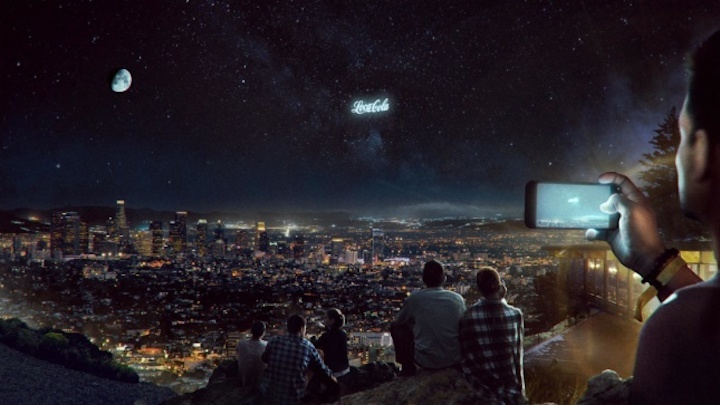
Earlier this year it was rumored that Pepsi had partnered with a Russian startup to potentially begin orbital advertising its products in LEO, furthering the commercialization of space. (Courtesy StartRocket)
This trifecta: low launch costs, a supply chain of matter and energy that’s already there, and a legal framework that can guarantee ownership of those resources, is the backend behind a new wave of proposals for architecture in space. These forces will keep that space wave going long after this post-Apollo nostalgia dies down.
Earlier this year NASA awarded $500,000 to AI SpaceFactory, “a multi-planetary architectural and technology design agency, building for Earth and space,” for their MARSHA project. MARSHA successfully demonstrated an ability to use in-situ resources—Martian soil (or regolith)—to 3D print the outer shell of a habitat for four humans. The European Space Agency (ESA) Moon Village concept has been in development for most of this decade. Norman Foster, who has also designed for Mars, contributed design work to the Moon Village project in 2016, and SOM released information about its own Moon Village work earlier this spring. And of course, Bjarke Ingels is in on it, too. His firm, BIG, is making plans for a Mars simulator complex outside Dubai, and Ingels told the online design journal SSENSE that this work is a case study for a future Mars city.
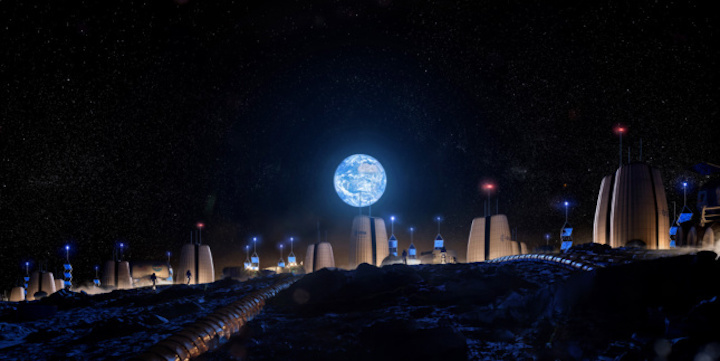
A view of the Earth from the Moon Village. (Courtesy SOM/Slashcube GmbH)
There’s beginning to be a long history to the notion that designing space for humans in space is a task that requires not just engineering, but architecture as well. At the inception of the Soviet Soyuz project in 1957, chief designer Sergei Korolev was unhappy with the capsule interiors that his engineers were drawing. The only architect working for the Soviet space program at that time was a woman named Galina Balashova, who was designing their office spaces. Korolev hired Balashova to redesign the habitable spaces of Soyuz, and later the space stations Salyut and Mir. Her work is still orbiting today as part of the International Space Station.
On the other side of the Space Race, the Americans hired industrial designer Raymond Loewy to do the interior fit-out for Skylab. Famously, he was the one who talked them into adding a window and suggested that the best place for it would be next to the zero-gee “dining table” on the station. Back on Earth, the Space Architecture Studio and Research Lab, founded by the late Yoshiko Sato at Columbia GSAPP, now continues at Pratt under the guidance of Michael Morris, Sato’s husband. For over 30 years, the University of Houston has hosted the Sasakawa International Center for Space Architecture. The chief space architect for AI SpaceFactory’s award-winning MARSHA design was Jeffrey Montes, an alum of the GSAPP studio. And Suzana Bianco, a graduate of the Houston program, was a copanelist at the Space Studies Institute conference in Seattle, presenting her New Venice habitat design.
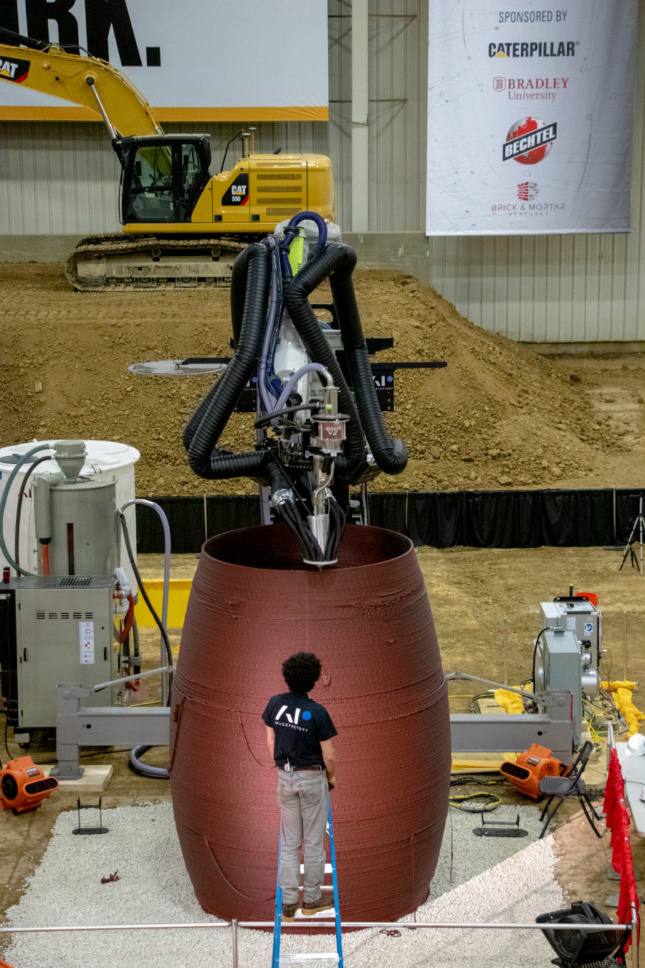
A one-third scale model of MARSHA being printed via robot arm at the physical mock-up stage of the NASA competition. (Courtesy AI SpaceFactory)
In technical circles within space science, the design of a total system—with launch capability, flight modules, crew or cargo space, and recovery—is known as an “architecture.” But in most of the presentations about various technical architectures for space travel and space settlement in Seattle last month—Bianco’s presentation being a welcome exception—there was little talk about the value that architects bring to those systems. No one knows space like architects do, and these threads that connect the (still largely speculative) work taking place in outer space today with the history of architectural space on Earth are too often neglected by those working in the field. Alongside all of this talk about “how?” the other question haunting the space settlement work being discussed at this conference and elsewhere was “who?”—as in “who will pay for all of this?” Even as the costs and barriers to entry drop, there is still uncertainty about the ways in which value might be designed into the projects that will help people live in space. Whether the users of the systems under design by these space architects are tourists, miners, hotelkeepers, or simple explorers, the question of “who?” is intimately tied up in the “why?” The architect Cedric Price famously asked, “Technology is the answer, but what was the question?” Maybe architects are the designers best positioned to ask, and even answer, these questions about space.
Quelle: The Architect's Newspaper
